
Altar Cross.
1786.
Silver:casting, stampling, gilding.
Wood: cutting.
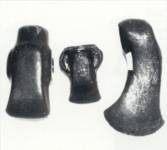
Lugged axe. The year 2,000 B.C.
Stone:cbiselling, grinding, drilling.
Socketed axe. The year 2,000 B.C.
Bronze: casting.
Lugged axe. The year 3,000 B.C.
Copper: casting. 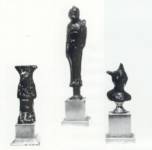
Roman bronze sculpture.
The IInd - IVth c.c. A.D.
-Ancient Egyptian God.
-A key-herma in the image of Dionis.
-Helios' head.
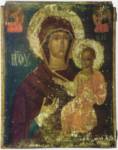
Icon "Virgin Hodegetria".
The late XVIth c.(?)
Wood, canvas, primer, tempera.
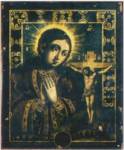
Icon "God's Mother Okhtyrska".
The XVIIIth c. Ukraine.
Wood, primer, oil.
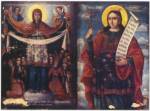
Icon "God's Mother Pokrova and the Image of St.
Paraskeva".
1752, renewed in 1895. Ukraine.
Wood, canvas, primer, oil.

Icon "St. George Snakegighter".
The late XVIIIth - the early XIXtg c. Russia.(?). Wood, canvas,
tempera.
|
The collection of books is kept in D. Chizhevsky
Regional Research Library, while the "Kunstkammer" is preserved
and exhibited in Kirovograd Regional Museum of Local Studies.
The following Catalogue devoted to this collection,
is published under the resolution of the Academic Council of the
Kirovograd Museum and at the expence of the International
"Renaissance" Foundation (Dniepropetrovsk aerial branch). We are
very much grateful to the Foundation for their sponsorship.
The oldest artefacts, which belonged to Olexander
Borisovich, are archaeological objects covering a rather long period –
from the year 4,OOO B.C. till the 1st century A.D. Ancient pottery is
presented in the collection by produce manufactured by masters of Dnieper
- Donets'ka (4,000 B.C.), Trypil'ska (4,000 B.C. - 3,OOOB.C),
Sabatinivs'ka (14 – 12 c.c. B.C.), Bilogrudovs'ka - Chornolis'la (11 –
8 c.c. B.C.) cultures as well as by antique samples. The collection
includes samples of Cheniakhovs'ka culture which existed on the same
historical period with Rome and sometimes tended to have the forms of art
very much like those of ancient Rome.
A special interest for researchers presents
iconography of the image of God's Mother. The image of God's Mother in the
icon "Virgin Hodegetria (Guide)" is created in the traditions of
medieval iconography. It is very strong emotionally and performed with
high professionalism.
God's Mother saving Konstantinopol from enemies is
depicted in the cathedral's icon "God's Mother Pokrova " (the
middle of the XVIIIth c.). This icon belonged to the church of the village
of Petroostriv. There is a mark on the icon witnessing that it was created
in 1752 and renewed in 1895. The icon "God's Mother Okhtyrska"
is performed in the traditions of the Rococo Ukrainian painting. The
traits of this tradition can be seen in golden nimbus of late Barocco
tradition, in general colour and in Ukrainian features of God's Mother.
But above all this tradition can be traced in the plot itself which was
characteristic for Ukrainian iconography in the middle of the XVIIIth c.
The small dainty home icon of the end of the XIXthc.
"Neopalyma Kupina" is distinguished by its lightness,
exquisiteness of painting, harmony of complex composition.
|
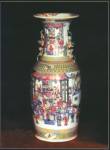
Vase. China.
Porcelian: modelling, multylayer painting, burning glaze 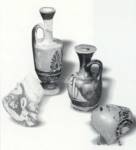
Antique pottery of the late Vth - the early IVth century
B.C.
-A fragment of a red - figured vase
with a picture of a woman looking into the mirror.
Aryballos lecythus. Neck: modern reconstruction.
-Cantharus.
-A part of a black - gigured vase with a picture of a heavy - armed greek
man-of-war.
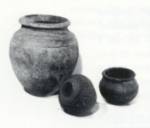
Pottery of Chrniakovs'ka culture.
The IInd - IVth c.c. A.D.
Ceramics.

Icon "God's Mother Kazanska".
The XViiith c.(?).
Wood, canvas, tempera. Covering: silver, engraving, pearls,garmet.
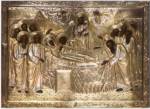
Icon "Death of God's Mother". The late XIXth c.
Russia.
Wood, primer, tempera. Covering: silver, sbiselling, engraving,
gilding.

A sketch for painting "St. Alexander Nevsky". The late XIXth c.


Side shutters of an icon and covering of shutters. The XVIIIth c.
Wood, primer, tempera. Silver: sbiselling.
|
 Olexander Ilyin's
KUNSTKAMMER
Olexander Ilyin's
KUNSTKAMMER














